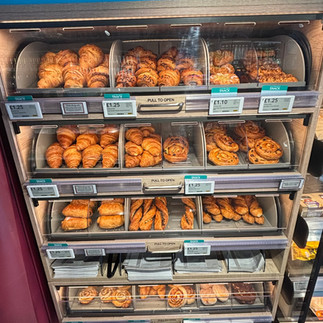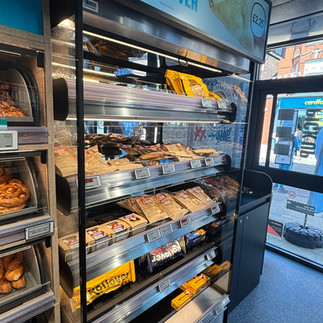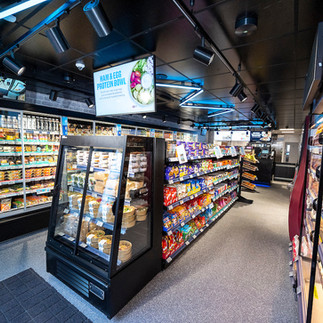Redefining the UK convenience store? Inside Co-op on the go, Solihull
- Gavin Rothwell
- Aug 1
- 6 min read
Earlier this week Co-op opened a different type of convenience store format that could have significant broader potential for growth across the UK market.

So what is a convenience store?
Definitions of convenience stores vary a lot by market, and sometimes even within them. The UK is a market where this is traditionally at the larger end of the convenience scale, sized at 200-300 sq m, with a considerable range of product, serving a variety of next 24 hour needs. But the more common global definition aligns around a 7-Eleven style format, a smaller, almost kiosk style operation, dedicated on serving more immediate needs. Each has its role, but what excites us is the ability for the different operators to learn from one another to create new missions and new solutions through their formats. Clearly, the smaller format store leans more heavily into food-to-go, which remains a key focus, and it's therefore attracting more interest from a variety of different businesses.
Many of these smaller format operations are set up and operated by clear specialists in this area, rather than larger supermarket chains shrinking their store footprints. And globally, there’s some impressive global innovation under way as the model is refined and developed. Some of those that we’re playing close attention to include:
Montreal – Couche-Tard (the parent of Circle K) is the reference point in the market, but it's seeing more competition, with KaleMart aiming to create a healthier convenience concept and Parkland opening standalone on the run (Marché Express) concepts
Poland – Žabka has been a runaway success story, with several thousand locations across the country and an ever strengthening food-to-go focus
Switzerland – Coop to go, Migrolino and avec all operate in this space, and continue to innovate in format design and proposition
Denmark & Sweden – 7-Eleven (Reitangruppen) operates excellent stores in both countries, serving a wide range of impulse needs with some impressive fresh food-to-go solutions as part of the proposition
Equally, many elements from the AH to go and REWE to go formats in the Netherlands and Germany are very much playing into this space.
What are the common ingredients that drive success across these formats?
Based on our work across the sector, we’d call out a number of features:
Fresh, differentiated food-to-go, typically including a hot element. The competitor set here is broad, propositions need to stand up effectively vs. key reference food-to-go specialists in the market in which they trade
Fresh bakery – this very much helps to set the tone of freshness for the store, and provides strong impetus to the breakfast mission in particular
Coffee – again, playing a key role in driving breakfast traffic
Ability to meet multiple missions through the day (and sometimes night), enabled by a good range of snacking and beverage options
Typically – counter based payment. There will likely be limited lines available behind the counter, with low complexity of preparation, but this gives scope to either offer a wider range of solutions or to better showcase it through the dedicated at till counter. There's also a service aspect to this.
The new Co-op on the go format in Solihull fits very much into this vein. This is the first store, but plans are already in place for 15 openings in the coming months.
So what’s the look, feel and focus in-store?
The images - from both our visit and from the Co-op - show many of the key features. This store concept is designed to fit into spaces of between 60 and 100 sq m - approximately one-quarter of the average Co-op convenience store in the UK. This is a format focused on immediate – or next few hours – consumption, and it’s been done very well by the Co-op.
Image source: FFI and the Co-op
Format-wise, inspiration has been taken from what’s been done in other markets, as well as drawing on the extensive existing food-to-go offer from Co-op, while developing this further in certain key areas. At the same time, within the format, there are some clear nods to what Greggs has been doing well for a long time. The counter-based proposition is a focal point towards the back of the store. This is for both payment and product, with a good range of pastries, bowls and toasties on offer, as well as the addition of pizza to the range. And the pizza, served either by the slice or whole, was tasty.
The healthier focused fridge on entry to the store was well-sited, with a differentiated range that helps set out from the start how this format is different. Digital signage here plays an important role – in a format like this, it’s not about what has become core retail media. Critical in this environment is to make the shopping journey simple and straightforward (as the likes of Greggs and Pret do in the UK to great effect), so the use of digital menu screens - and selective digital product call outs across the rest of the store - works well.
Within the menu as well, we liked the way the full menu was fixed on two of the screens, with the third rotating through featured products. In most food-to-go missions, the need to display your wares quickly to the customer is key – many will lose patience if they’re forced to wait for screen rotation.
But many missions in-store won't need the counter-based offer - and to help serve customers on these missions faster there are two self-scan payment units in this store, next to the counter.
Co-op's meal deal was available in-store, but it felt like this was a secondary rather than primary message. There's also a focus on targeting evening delivery - even though this store closes its doors at 7pm.
Five things we liked about the store
The use of the counter helped strengthen food credentials. Key will be to maximise its effectiveness, manage product within it and look at how to make the counter stand out even more. We tried the pizza, which surpassed our expectations.
Dedicated fresh lines at the front of store. These felt like a new addition to the range - a good selection of lunch (and/ or dinner) bowls, plus breakfast options like overnight oats and bircher muesli in the vein of a Pret style solution.
The breadth of offer was strong, with solutions for most food-to-go missions in place.
Layout was logical, with the counter at the rear of the store. The counter is manned, but also oversees the two self-scan checkouts.
Good mix of branded and Co-op own brand in the range.
How could the format develop further?
Our initial view of the store is very positive. Here are some considerations we’d throw into the mix for future store development:
This store overall feels quite tight – there is a lot going on in-store. It does work, but one consideration will be whether the shopping experience could be improved in a less dense store?
For this store, where opening hours are 7am-7pm, we wonder whether the beer & wine section fits. Beer & wine is undoubtedly a strong fit in many stores like this in other markets, particularly those with a strong afternoon/ evening trade, but it might not always be required in more daytime focused stores. Here for example it will probably be relying on after hours delivery for much of its volume, but if this is the focus, it might not need so many facings in the store itself.
More global cuisine development – it feels there is good scope for a stronger sushi/ poké focus, while right now the focaccia style sandwich is becoming more popular in more locations. Range development here could help add more colour and vibrancy to the counter based proposition, as it does in many Irish convenience store locations and also at 7-Eleven's Danish and Swedish stores.
Healthier hot food – last week, visiting food-to-go specialists in Paris we saw a great range of hot bowls at several locations. A selection of these could be a helpful addition to the store, whether for heating in-store or at home/ office.
Seating – the tight layout of this store does preclude it here, but this could be an option for future stores.
Central ambient aisle – admittedly, we were more drawn to the fresh product as a differentiator within the range, so we paid less attention to this part of the store. Our initial view however is that there could be scope to focus this part of the store more on sub-missions, rather than on the traditional product categories. Even if this involves less range, in a store of this size, it could be that better signposting the solution they meet could help sell more. There's a balance to be had, as in this type of format, compared with the likes of Pret and Greggs (both trading nearby this store) having key branded lines can be an important differentiator.
Different meal/ snack deals. From an operational perspective, this could bring challenges, but across Europe we've seen effective examples of this, snacking deals across food-to-go specialists in Paris, breakfast deals at 7-Eleven in Sweden and multi-buy discounts on beverages in Denmark are just some that we've seen that could play a role.
There's lots of opportunity here for the right format, and this is a strong start from the Co-op. Clearly, there will be many considerations in place for next steps, and, like any format, there will be learnings from the first iteration. We look forward to seeing how the format evolves and develops and will follow keenly the next stages of development.




































